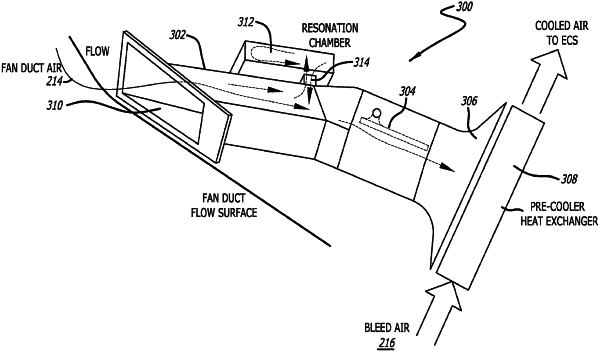| CPC F01D 9/06 (2013.01) [F01D 17/145 (2013.01); F01D 25/12 (2013.01); F05D 2220/323 (2013.01); F05D 2250/221 (2013.01); F05D 2260/213 (2013.01); F05D 2260/232 (2013.01); F05D 2260/963 (2013.01)] | 18 Claims |

|
1. A system for use in a gas turbine engine including an engine core having a compression stage, the system comprising:
a first duct comprising an air inlet end and an air outlet end;
a valve within the first duct and configured to open to allow or close to prevent fan duct air from the air inlet end to pass through to the air outlet end of the first duct;
a second duct comprising a first end and a second end, wherein the first end is coupled to a sidewall of the first duct and configured to allow the fan duct air to flow from the first duct to the second duct;
a resonance chamber comprising a volume of air and coupled to the second end of the second duct, wherein the volume of air in the resonance chamber causes the fan duct air in the second duct to oscillate in the second duct at a predefined frequency; and
a pre-cooler heat exchanger coupled at the air outlet end of the first duct such that when the valve is open, the fan duct air in the first duct provides cooling air to cool bleed air at the pre-cooler heat exchanger, the cooled bleed air being provided to an environmental control system (ECS) of an aircraft;
wherein the cooling air in the first duct and the bleed air are taken from air received by the gas turbine engine, the bleed air being compressed at the compression stage, the cooling air bypassing the compression stage;
wherein the valve closing causes the fan duct air to oscillate within the first duct while the volume of air in the resonance chamber oscillates to reduce the fan duct air oscillation in the first duct;
wherein the second duct and the resonance chamber are sized according to:
f=c/2π√S/VL
where f is a frequency associated with the first duct, c is the speed of sound, S is a cross-sectional area of the second duct, V is a volume of the resonance chamber, and L is a length of the second duct; and
the first end of the second duct is coupled to the sidewall of the first duct between the valve and the air inlet end such that air oscillations generated in the first duct by the fan duct air are reduced by the resonance chamber when the valve is closed.
|